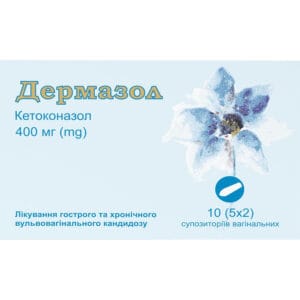No products in the cart.
Great news! The Canada Post strike is over! We’re resuming deliveries to Canada!
Excellente nouvelle ! La grève de Postes Canada est terminée ! Nous reprenons les livraisons vers le Canada !
Great news! The Canada Post strike is over! We’re resuming deliveries to Canada!
Excellente nouvelle ! La grève de Postes Canada est terminée ! Nous reprenons les livraisons vers le Canada !
[category_image]
Dermazole vaginal suppositories 400 mg 10 pcs.
$33.00
Dermazole vaginal suppositories 400 mg treat and prevent acute and recurrent candidiasis, providing strong local antifungal action with minimal absorption.
Categories: Dermatology
Brand: Kusum Healthcare
Pharmacological properties
Pharmacodynamics of Dermazole. Ketoconazole is a synthetic derivative of imidazoledioxolane. It has a pronounced fungicidal and fungistatic effect on dermatophytes (trichophyton spp., epidermophyton floccosum, microsporum spp.), yeast fungi (candida spp., pityrosporum spp., torulopsis spp, cryptococcus spp, rhodotorula spp.), dimorphic and higher fungi (zoomycetes). Aspergillus spp., Sporothrix schenkii, some dermatiaceae, mucor spp. and other Phycomycetes, with the exception of entomophthales, are less sensitive to ketoconazole. Ketoconazole is also active against cocci (staphylococcus spp., streptococcus spp.).
The mechanism of action is aimed at suppressing the biosynthesis of ergosterol and changing the lipid composition of the membrane of fungi, which leads to their lysis. The drug is also active against pathogens resistant to antifungal antibiotics (nystatin, levorin), as well as clotrimazole. The development of secondary resistance during treatment with ketoconazole has not been noted so far.
Pharmacokinetics. When used intravaginally, the drug is poorly absorbed, only a small amount (less than 1%) enters the systemic bloodstream. C max in blood plasma after the use of 400 mg of ketoconazole ranges from 0-10.7 ng / ml, which is considered trace and has no systemic effect.
Indication of Dermazole
Treatment of acute and chronic recurrent candidiasis. Prevention of vaginal fungal infections with reduced body resistance and against the background of treatment with drugs that disrupt the normal vaginal microflora.
Application
Release the suppository from the strip and insert it deep into the vagina while lying on your back with your knees bent and your legs pulled to your chest or while squatting. Suppositories should not be cut into pieces, as such a change in the storage conditions of the drug may lead to a disruption in the distribution of the active substance. Use 1 suppository per day before bedtime for 3-5 days. If necessary, repeat the course of treatment until clinical and laboratory recovery is confirmed. In chronic candidiasis, use 1 suppository for 10 days.
It is recommended to wash your hands after using the drug to prevent accidental contact of its residues with the eyes, mucous membranes or skin.
Contraindication
Hypersensitivity to the components of the drug.
Side effects
They generally occur rarely and quickly disappear after discontinuation of the drug.
Local reactions: irritation of the vaginal mucosa, accompanied by itching, burning sensation, hyperemia.
Skin and subcutaneous tissue disorders: itching, rash, hyperemia.
Immune system disorders: hypersensitivity reactions, including anaphylactic and anaphylactoid reactions, angioedema, urticaria.
Gastrointestinal tract: nausea, abdominal pain.
Nervous system: dizziness.
Special instructions
In rare cases, local allergic reactions are possible in the sexual partner. To reduce the risk of recurrence of the disease, simultaneous treatment of the sexual partner is recommended. Contact with latex contraceptives (contraceptive diaphragms, condoms) should be avoided due to a decrease in the reliability of mechanical contraception, therefore the possibility of pregnancy or infection with sexually transmitted diseases cannot be ruled out. During treatment, sexual contact should be avoided. The drug is recommended to be used at night, as it has an osmotic and drainage effect, which is accompanied by an increase in vaginal discharge. It is recommended to use sanitary pads at night during the period of treatment with Dermazole.
If adverse reactions develop, including hypersensitivity reactions, the drug should be discontinued and a doctor should be consulted.
The drug contains butylhydroxyanisole (E320), therefore it may cause local skin reactions (e.g. contact dermatitis) or irritation of the mucous membranes.
Use during pregnancy and lactation. Although systemic absorption of ketoconazole is extremely low or absent after intravaginal administration, there are no adequate controlled clinical studies of the safety of ketoconazole in pregnant women. The drug should not be used in the first trimester of pregnancy.
In the II-III trimesters of pregnancy and during breastfeeding, the drug should be used only if the expected benefit to the mother outweighs the potential risk to the fetus or child.
Children. There is no experience with the use of the drug in children, so it should not be prescribed to this age group of patients.
The ability to influence the reaction rate when driving vehicles or other mechanisms. Usually does not affect, but the possibility of dizziness should be taken into account in people with hypersensitivity.
Interactions
When ketoconazole is used simultaneously with rifampicin and isoniazid, the concentration of ketoconazole in the blood plasma decreases. When used simultaneously with cyclosporine, indirect anticoagulants and methylprednisolone, ketoconazole may increase the concentration of the latter in the blood plasma. The practical significance of these interactions in treatment with ketoconazole in the form of vaginal suppositories is unknown.
Overdose of Dermazole
In case of overdose, local reactions are possible: hyperemia, burning, itching, irritation of the vaginal mucosa. In such cases, douching with water is recommended.
Storage conditions
At a temperature not exceeding 25 °C.
You may also like









